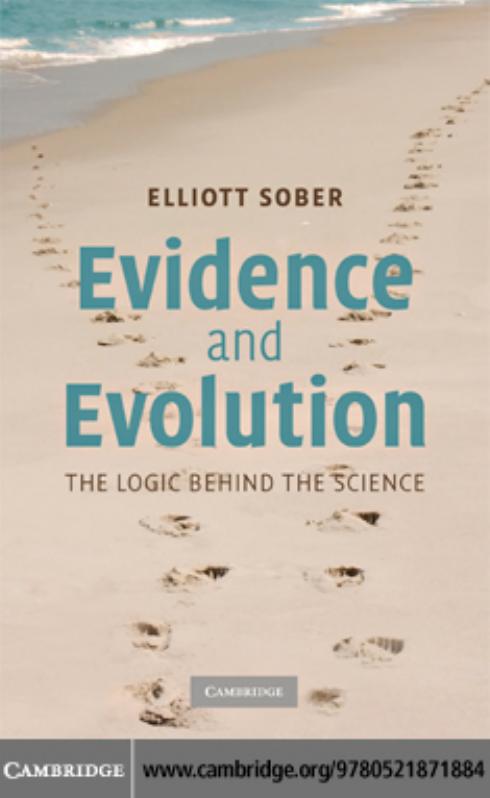Evidence and Evolution: The Logic Behind the Science by Elliott Sober

Author:Elliott Sober [SOBER, ELLIOTT]
Language: eng
Format: epub, pdf
Tags: General, Life Sciences, Science, Philosophy, Philosophy & Social Aspects, Evolution (Biology), Evolution, Natural Selection, Epistemology, Probabilities, Probabilities - Philosophy, Evidence, Evolution (Biology) - Philosophy, Natural Selection - Philosophy
ISBN: 9780521692748
Google: c1VehakcuuQC
Amazon: 0521692741
Publisher: Cambridge University Press
Published: 2008-01-15T10:00:00+00:00
190
Natural selection
An important theme from Chapters 1 and 2 was that testing is con-
trastive: To test a theory, you need to test it against alternatives.1 This seems to entail that testing evolutionary theory means testing it against
creationism. If so, why is creationism so rarely discussed in scientific
publications? Are biologists willfully burying their heads in the sand? In
the last chapter I argued that the hypothesis that an intelligent designer
made the complex and useful traits that we observe organisms to have is
untestable. However, if intelligent design is a sorry excuse for a scientific
theory, where is evolutionary theory to find a more worthy opponent? If
testing is contrastive, there must be one. This line of questioning has a
false presupposition. Evolutionary theory describes a number of possible
causes of evolution. There is natural selection but there also is mutation,
migration, random genetic drift, recombination, linkage, inbreeding, as
well as others. The theory allows for the possibility that different traits in
different lineages might evolve for different reasons; there is no presup-
position that one size fits all. What evolutionary biologists spend their
time doing is testing one evolutionary hypothesis against another. For
example, an important project in population genetics involves using data
on the DNA sequences present in different species to test selection against
drift, an undertaking I’ll discuss in §3.9. Contrastive testing occurs within
evolutionary biology, not between evolutionary biology and something
outside. To talk about testing evolutionary theory is a bit like talking
about testing chemistry. Evolutionary biology, like chemistry, is a field or
discipline that contains many theories; evolutionary biologists test evolu-
tionary hypotheses against each other.
Does this mean that there are presuppositions internal to evolutionary
biology that never get tested? For example, when population geneticists
use sequence data to test selection against drift, they usually assume that
the species considered all derive from a common ancestor. Not only that,
they usually assume a specific phylogenetic tree, one that describes which
species are closely related to each other and which are related only more
distantly. It is true that population geneticists usually make these
phylogenetic assumptions, but it is false that those ‘‘assumptions’’ are
merely assumptions. As we will see in the next chapter, the hypothesis of common ancestry can be tested, and the same is true of more detailed
claims about phylogenetic relationship. It is important to distinguish the
1 This isn’t true for theories that (together with independently justified auxiliary propositions) have deductive implications about observations; however, for theories that merely confer nonextreme probabilities on observations, the dictum is correct.
Download
Evidence and Evolution: The Logic Behind the Science by Elliott Sober.pdf
This site does not store any files on its server. We only index and link to content provided by other sites. Please contact the content providers to delete copyright contents if any and email us, we'll remove relevant links or contents immediately.
Enlightenment Now: The Case for Reason, Science, Humanism, and Progress by Steven Pinker(7170)
A Journey Through Charms and Defence Against the Dark Arts (Harry Potter: A Journey Through…) by Pottermore Publishing(4773)
The Immortal Life of Henrietta Lacks by Rebecca Skloot(4504)
A Journey Through Divination and Astronomy by Publishing Pottermore(4332)
Elon Musk by Ashlee Vance(4007)
Origin Story: A Big History of Everything by David Christian(3632)
COSMOS by Carl Sagan(3539)
Alchemy and Alchemists by C. J. S. Thompson(3435)
Enlightenment Now by Steven Pinker(3324)
Bad Pharma by Ben Goldacre(3289)
Shadow of Night by Deborah Harkness(3278)
Inferior by Angela Saini(3260)
A Mind For Numbers: How to Excel at Math and Science (Even If You Flunked Algebra) by Barbara Oakley(3206)
Origin Story by David Christian(3133)
The Code Book by Simon Singh(3056)
Signature in the Cell: DNA and the Evidence for Intelligent Design by Stephen C. Meyer(3055)
The Elements by Theodore Gray(2982)
A Brief History of Time by Stephen Hawking(2947)
A Journey Through Potions and Herbology (A Journey Through…) by Pottermore Publishing(2818)
